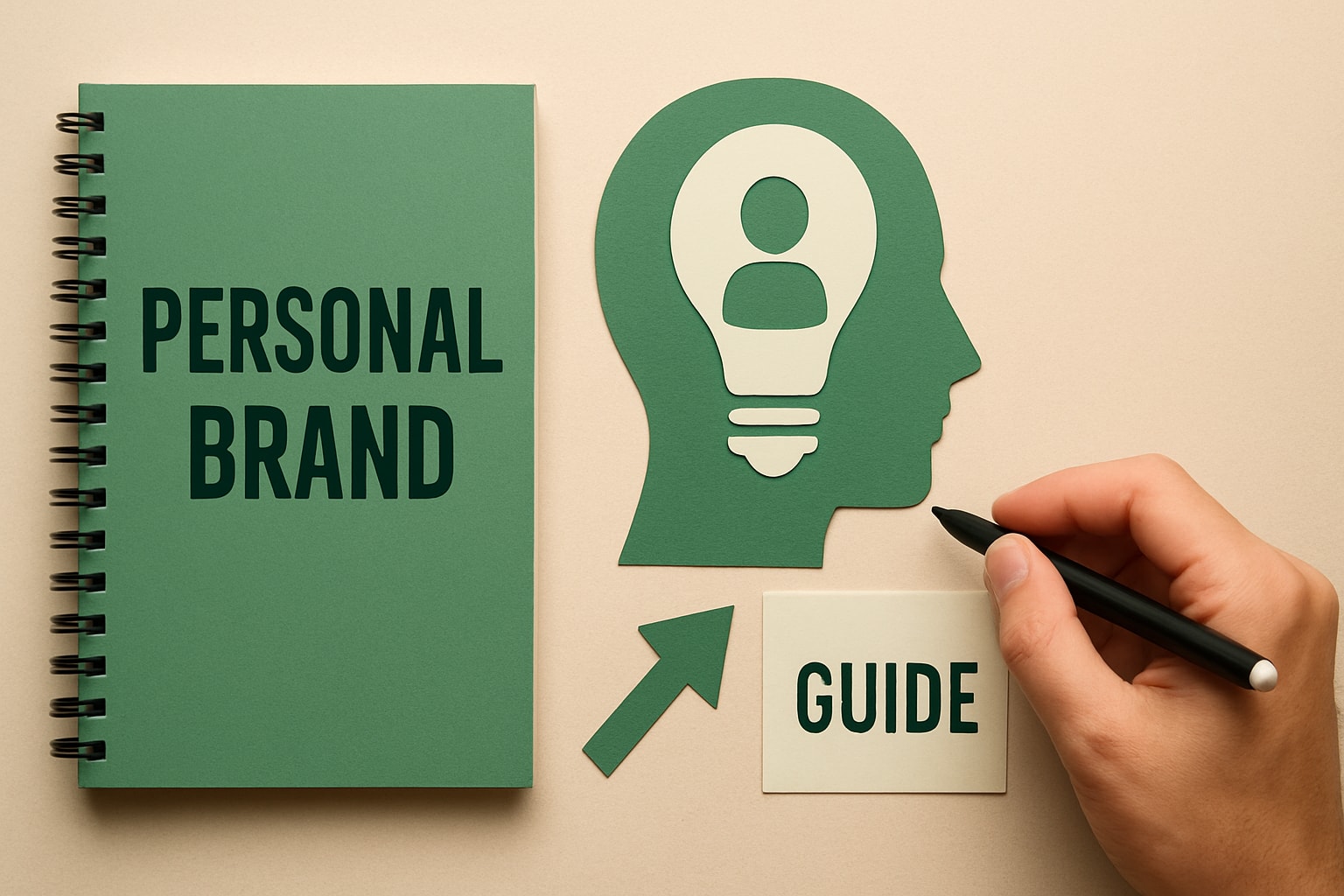
Personal Brand Guide 2025: Build Your Unique Identity
Your personal brand isn’t just how you show up online. It’s how you’re remembered.
As Jeff Bezos famously said, “Your brand is what people say about you when you’re not in the room.” In 2025, personal branding is less about polish and more about reputation, voice safety, and alignment.
This guide explores the psychology behind personal brand perception, how to define your brand identity, and ways to align your voice across every platform.
The digital world expects more than a shiny profile. Your personal brand is your reputation, built on perception, projection, and congruence. Learn how to root your brand in clarity, not just performance, for trust, alignment, and growth. Follow this guide to build a unique, resilient personal brand in 2025.
The Real Meaning of A Personal Brand in 2025
Your personal brand isn’t just a polished profile or curated feed. It’s your reputation in motion—the story your presence tells through tone, timing, and trust.
In 2025, personal branding is less about being seen and more about being aligned. When your values, identity, and message hold steady across every interaction, you build a brand that lasts.

What is a Personal Brand?
At its core, a personal brand is your reputation. Not just how you show up, but how you’re remembered. It’s the echo of your values and the clarity of your voice across every touchpoint.
Most people think personal branding is about online visibility. But it’s really about how your tone, intention, and presence land with others—especially after the moment ends.
Reputation Psychology: Perception, Projection, Congruence
Reputation isn’t built on image. It’s shaped through three key layers:
- Perception — how others experience you
- Projection — how you present yourself
- Congruence — how well your internal values match your external voice
When these layers align, your personal brand builds trust and influence. When they don’t, it creates confusion. For you and for everyone around you.
Personal Brand vs. Public Persona
A personal brand isn’t just the version of you people see in public. It’s the version they believe.
Many founders confuse public persona with a personal brand. They craft a confident presence outwardly, but communicate with uncertainty behind the scenes. That disconnect creates tension. Teams notice when what’s said online doesn’t reflect what’s practiced internally.
Real alignment builds clarity. And clarity builds trust.
Internal and External Impact
Your personal brand isn’t just an external asset. It’s a lever for internal alignment and culture. Teams take their cues from how leaders speak and show up. If your voice feels filtered or inauthentic, that disconnect affects morale, trust, and decision-making.
Externally, your brand shapes how others assess your credibility. Over 90% of recruiters now use LinkedIn to evaluate reputation, not just credentials. It’s not about polish. It’s about perception.
Leadership Leverage and Voice Safety
Personal brand is a leadership tool. Not a marketing trick. When it’s grounded in voice safety—the ability to speak clearly without self-censoring—your influence grows.
Research shows that leaders who are overly concerned with managing reputation are often perceived as less effective. Authenticity matters more than image. (Reputation concern influences perceived leadership).
At Kedra&Co, we don’t build personal brands around performance. We build from clarity. When your inner voice and external message align, strategy holds. When they drift apart, messaging fractures or gets handed off entirely.
That’s why we guide founders through emotional brand diagnostics, tone unbraiding, and root-mapping. The result is a brand that feels steady, congruent, and true across every room it enters.
Step 1: Diagnose Your Current Reputation & Voice
Diagnosing your personal brand is about holding up a mirror, not just to your public image, but to the story your voice tells behind closed doors. It’s the difference between how you hope to be seen and how you’re actually remembered—by your team, your peers, and your broader audience.
If you’re like most founders, the instinct is to jump straight to performance: polish the LinkedIn profile, refresh the website, post more often. But a strong personal brand starts with reputation, not presence. Before you reshape your message, you need to understand what others truly experience.

Why Diagnose Your Personal Brand?
The first move is to pause. Ask yourself:
What story does my voice leave behind?
Your personal brand is the echo of your values, your habits, and your leadership style. It’s shaped by everything from your speaking tone to your Slack replies.
Many leaders confuse personal brand with their role or public persona. This confusion creates a gap between internal alignment and external clarity. When your team senses one version of you, but the world sees another, trust erodes.
Tools to Audit Your Reputation
Start with tools that help you see clearly.
A 360-degree feedback process can be revealing. Invite peers, direct reports, and clients to share how they experience you. Keep it anonymous to create safety and invite truth.
Review your digital presence. Look through past talks, posts, and public content. Notice patterns. What tone shows up most? What message repeats, even when unintentional?
Ask direct questions. One of the simplest is:
“What three words come to mind when you think of me?”
This uncovers both strengths and blind spots.
For a deeper audit, consider using emotional brand diagnostics or working with a trusted advisor. And if you find yourself stuck, start with a resource like Overcoming Personal Brand Challenges to move through the most common roadblocks.
The Perception Gap: Closing It Matters
Most leaders discover a gap between how they see themselves and how others experience their voice. You might believe you're leading with clarity, but your team describes your messaging as guarded. That disconnect isn’t just uncomfortable—it erodes trust and influence.
According to a Forbes Coaches Council report, 80% of executives believe their leadership communication is clear and effective, but only 30% of their teams agree. That kind of perception gap weakens credibility and creates friction across internal and external brand touchpoints.
If you find misalignment, treat it as data, not failure. It’s not a cue to perform. It’s a signal to pause, reflect, and realign.
Self-Perception
External Perception
Impact
Transparent
Guarded
Erodes trust
Confident
Hesitant
Confuses team, weakens brand
Consistent
Inconsistent
Reduces influence
Alignment builds brand resilience. Not because you’re perfectly perceived—but because you’re willing to listen, adjust, and stay true across every space you lead.
Tone Unbraiding: Finding Your True Voice
Most of us carry language that isn’t fully ours. We pick up communication habits from former teams, mentors, cultural roles, or early survival strategies. Over time, those patterns braid into our personal brand—quietly shaping how we speak, lead, and respond.
Tone unbraiding is the practice of separating what’s true to you from what was borrowed, inherited, or protective.
Start by journaling on this question:
When have I felt misunderstood in my leadership?
Notice what comes up. Are you softening your message to avoid conflict? Are you using words that feel strategic but not honest?
Patterns point to origin. Emotional brand diagnostics can help uncover what’s yours and what can be released. Clarity begins when your voice stops trying to mimic safety and starts telling the truth.
Voice Rupture: Turning Pain into Growth
Every founder faces rupture. A moment when your voice was dismissed, misread, or muted. These moments sting—but they also sharpen.
Instead of pushing past them, document them. Ask:
- What triggered this moment?
- What story did I tell myself after?
- How did it shape the way I show up now?
Voice rupture, when named, becomes a tool. It shows you where your brand bent under pressure—and where you can now lead with more congruence.
Resilient personal brands aren’t built on control. They’re built on the willingness to listen, shift, and speak from a place that’s real.
Step 2: Define Your Unique Brand Narrative
Your personal brand is not just a polished pitch or a highlight reel. It’s the story you carry. Your lived experiences, values, and the proof behind your presence. It’s what shapes how others remember you, long after the moment ends.
Most founders skip this part. They default to what sounds credible instead of what feels true. But in my work, I’ve seen that the strongest personal brands are built from clarity, not performance. That’s what creates trust. That’s what holds.
Defining your brand narrative means tracing your story back to its roots. Look for the moments that shaped how you speak and lead—both the pivotal and the painful. Let those moments form the core of what you share.
You don’t need to say what people expect.
You need to say what’s true.
That’s where strength begins.

Identifying Signature Stories
Every personal brand is built on a handful of signature stories. These are the moments that shaped your perspective, tested your values, or forced you to make a choice under pressure.
Think about the times you pivoted, overcame failure, or stood up for something that mattered. These stories become the backbone of your personal brand, not just for external audiences, but for your own clarity too.
When I work with founders, I ask them to list three pivotal moments in their journey. What did they learn? How did those experiences rewire their sense of self or leadership? These are not just anecdotes—they are proof points that anchor your personal brand in lived reality.
The Role of Emotional Intelligence in Storytelling
A strong personal brand begins with emotional intelligence. Not credentials. Not charisma. Just clear self-awareness.
Vulnerability is what creates connection. When you share the “why” behind a hard decision or own the lesson behind a misstep, people lean in. It builds trust—inside your team and across your audience.
It’s not about being impressive. It’s about being real.
For example, a founder who shares the story of a failed launch and what it revealed will build more credibility than one who only showcases wins. That honesty signals strength, not weakness. It shows you know yourself, and that you lead with integrity.
Framework: The Proof Pyramid
To bring structure to your personal brand, I use what I call the “proof pyramid.”
At the base is your lived experience. This is what you’ve actually done and survived. Above that sits your expertise. Your skills and results that can be verified. At the top is your vision. This is where you’re heading and why.
Layer
Description
Vision
Your future direction and purpose
Expertise
Skills, credentials, achievements
Lived Experience
Defining moments and real stories
By building your personal brand from the ground up, you avoid the trap of sounding generic or performative. Your story becomes a foundation, not a facade. It speaks with depth and earns trust without needing to prove anything.
Narrative Clarity and Identity-Role Separation
Too often, founders blur the line between their personal brand and the role they play. When you tie your identity too closely to your current title or company, your messaging risks feeling forced or inauthentic. The key is to clarify the difference between what you do and who you are.
Your personal brand should not collapse into your job description. It should reflect your values, your story, and the leadership traits that remain true no matter the context.
If you want a deeper dive into this, I recommend reading about the difference between brand storytelling vs. founder story. This distinction helps you root your personal brand in clarity, not just in the performance of your current position.
When your identity is separate from your current role, your brand becomes more adaptable. It stays steady through pivots, title changes, or even exits.
Defining your narrative is an act of self-awareness. When your message is rooted in lived experience and not just current positioning, you create a personal brand that can grow with you and still feel true.
Step 3: Align Your Brand Across All Touchpoints
Alignment isn’t about sameness. It’s about making your personal brand recognizable—no matter where or how people encounter you. When your message is consistent across LinkedIn, team meetings, and casual conversations, trust grows. If your tone drifts or your values feel unclear, people notice. That’s when trust erodes, both inside your company and out in the world.
I’ve seen founders pour energy into a polished online presence, only to ignore the internal voice their team hears daily. This disconnect leads to confusion. If your LinkedIn profile is bold but your internal updates are hesitant, your personal brand feels fractured.
According to a study by Lucidpress and Demand Metric, nearly 90% of organizations agree that brand consistency is important, yet fewer than half say they’re delivering it. The same is true of personal brands. When your tone, timing, and message shift depending on the platform or room, people struggle to know what you really stand for.
Consistency isn’t about repeating a script. It’s about letting your values show through everywhere you speak and lead.
That kind of alignment builds trust. Not just with your audience, but with your team and yourself.
And it starts with systems. Not slogans.
Simple audits. Tone anchors. Honest feedback.
Structures that support a voice you don’t need to perform.

Building a Scalable Voice System
A scalable voice system is the backbone of your personal brand. Without it, your message drifts, especially as your team grows or your platforms multiply. I always advise founders to create clear guidelines for tone, language, and presence. This isn’t about scripting every word. It’s about setting boundaries for how your personal brand sounds everywhere.
Start with these essentials:
- Voice principles: Three to five core traits that define your communication style (for example: direct, warm, and candid).
- Do’s and don’ts: Specific examples of what fits your personal brand and what doesn’t.
(Example: “Do ask clear questions. Don’t over-apologize.”) - Story banks: A living document of signature stories, metaphors, and proof points.
This keeps your message grounded in lived experience.
A practical tool I often recommend is the voice and tone map. It helps your team communicate with clarity and confidence, whether they’re writing a press release or replying to a Slack message. It outlines how your brand speaks in different contexts, so your message stays consistent—even when you’re not the one writing it.
This map should grow with you. Schedule regular reviews—once a quarter at minimum—to check for drift, misalignment, or language that no longer fits.
At Kedra&Co, tone mapping is one of the first things I guide founders through. Once your voice is clear, I offer ongoing support, whether through quarterly check-ins or retainer partnerships, so your message stays rooted as you scale.
Internal Brand Alignment: Team Trust & Clarity
Internal alignment is where your personal brand becomes real. If your team can’t repeat your story or values, the message gets lost—especially during launches, pivots, or pressure.
I’ve worked with founders who sound inspiring online, but whose teams can’t explain what they stand for. The result? Slower decisions, unclear direction, and diluted energy.
Here’s how I help leaders build trust inside the brand:
- Hold regular brand huddles
Create space for your team to hear, reflect on, and engage with your core message. - Use feedback loops
Ask your team how they would describe your vision in their own words. Let clarity rise from inside. - Document your voice
Create accessible tools—think living brand playbooks, not static slides—that reflect your tone, principles, and story.
When your team understands and owns the message, everything works better. People make clearer decisions. They represent your brand accurately. They feel safe giving feedback because they trust how you’ll respond.
That’s voice safety in action. Not just consistency but clarity people can count on.
Step 4: Grow & Protect Your Personal Brand in 2025
In 2025, growing and protecting your personal brand is not about polish. It’s about shaping how your voice is experienced, remembered, and trusted.
The landscape is moving fast. Digital platforms evolve. AI reshapes communication. Transparency is no longer optional. In this environment, your personal brand is not a marketing tactic. It’s a leadership asset.
When it’s clear and steady, your brand builds trust.
When it drifts, you lose traction.
As a founder or leader, your personal brand is the throughline that keeps your message grounded as you grow.
It’s not just what you say. It’s how clearly people feel who you are, wherever they meet you.
Proactive Reputation Management
Managing your personal brand in this era means being intentional, not reactive. I always recommend regular audits — monitoring where your name appears, listening to how your team and audience describe you, and updating your story as you grow.
Ask yourself: What are people saying about my personal brand when I am not present?
Use 360‑degree feedback, anonymous surveys, and digital footprint reviews to get an honest picture. Research shows your reputation really matters: a study found that an individual’s “reputation” on an online platform significantly increased their persuasion rate — by 31% when adding 10 reputation‑points.
It is also critical to address feedback openly. When you spot patterns of confusion or inconsistency, do not brush them aside. Instead, use those moments to clarify your message and reinforce your values. For founders who want to align reputation with performance goals, I recommend balancing brand and performance as a practical resource.
Psychological Safety and Resilience
True personal brand growth depends on feeling safe enough to express your real perspective. This is what I call voice safety—the ability to speak and act from your core, even under pressure. When you operate from this place, your team trusts you, and your audience sees your authenticity.
But setbacks and criticism are inevitable. The difference is how you respond. Leaders who weather a public rupture by returning to their core values, rather than reacting defensively, rebuild trust faster. Your personal brand is most resilient when you separate your identity from your role, allowing you to adapt without losing your voice.
Research highlights that reputation is not just a shield—it shapes your persuasive power and impact, especially in online settings. For more on how your personal brand influences your credibility, see Influence via Ethos: On the Persuasive Power of Reputation in Deliberation Online.
Practical Steps to Protect and Evolve
A resilient personal brand isn’t built in big moments. It’s shaped through steady habits. Here’s what I recommend:
- Schedule quarterly reviews to reflect on your narrative, tone, and audience feedback
- Document lessons from both wins and mistakes—track patterns over time
- Update your message system when your vision or role shifts
- Invest in trusted support during high-stakes seasons—coaches, brand strategists, or both
- Practice ongoing tone unbraiding—notice where your voice feels off and trace the source
When your personal brand is treated as a living system, it becomes adaptable. You can shift platforms, evolve your offers, or navigate challenges without losing your core.
Table: Personal Brand Growth and Protection Strategies
Challenge
Proactive Response
Outcome
Negative feedback
Honest dialogue, clarify values
Strengthened trust, clear perception
Public controversy
Return to core narrative, transparency
Reputation recovery, deeper alignment
Internal misalignment
Team brand huddles, voice audits
Unified messaging, team trust
Platform changes
Update brand guide, review presence
Consistent identity, adaptability
Conclusion
The strongest personal brands in 2025 are rooted in self-awareness, not performance. They are built on daily choices—staying open to feedback, protecting psychological safety, and evolving your story as you grow. When you approach your personal brand with intention, you create a foundation that supports both personal and business growth.
Keep your narrative clear, your values visible, and your voice safe. The way people remember your personal brand tomorrow depends on how you show up today.
Kedra&Co’s Approach to Brand Messaging Clarity
At Kedra&Co, I believe your personal brand is not just about how you show up online, but how your voice is remembered when you leave the room. It’s reputation, not just presence. Many founders confuse a polished persona with authentic leadership, but true clarity comes from the inside out.
We start by guiding you through emotional brand diagnostics. This means tracing your voice patterns back to their roots, whether from past leadership imprinting or early ruptures. By unbraiding inherited habits and getting to the core of your story, we help you build a personal brand that is resilient and real.
Our process blends business strategy with psychology. We focus on root-mapping and tone unbraiding, so your brand voice stays aligned through launches, pivots, and even moments of rupture. It’s about congruence—making sure your internal clarity matches external perception, which research on authentic leadership shows is essential for trust.
When your personal brand is anchored in clarity:
- Your team trusts your direction
- Your audience feels your intent
- Your message remains steady through change
If you’re at an inflection point and ready to shape a voice that reflects who you are—not just what you do—I’d be honored to support you. Learn more about Kedra&Co.
Let’s find the version of your voice that lasts.
Let’s build it from the inside out.
Let’s find your real voice.
Ashley Kedra


